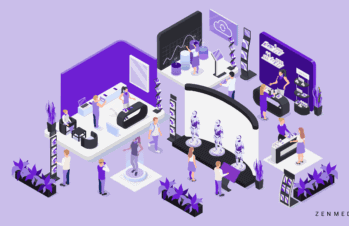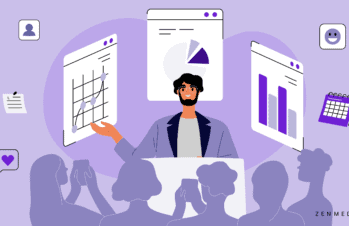Since first emerging in China around the middle of last December, the COVID-19 coronavirus disease has dramatically spread across the world, becoming a global pandemic within just a short matter of months. This growing health crisis has fundamentally changed our everyday lives in a number of ways. And, at Zen Media, we’ve also seen how much the business world has been turned on its head as well.
In the wake of this pandemic, trade shows that B2B marketers have spent so long planning have been canceled. According to data gathered by Bloomberg News, so far, the spread of COVID-19 has scuttled over 50 major corporate events with an estimated attendance of almost 1 million people.
A canceled trade show can either be a minor setback or a major issue for businesses, depending on the timing, scale, and a company’s specific plans. Missing out on shows that you’ve planned and budgeted for might seem, in the moment, as if you’re missing out on a whole bunch of leads that you could be converting into customers. And you may even be having nightmares about your MQLs and SQLs.
But there are definitely still a number of things you can do digitally that, when done right, can offer a similar level of lead generation results that you would get from being at a trade show.
Here are a few things you can do, in replacement of being at a trade show canceled due to the COVID-19 pandemic, to stay on top of your B2B lead generation goals.
Hold Your Own (or Attend Some) Virtual Events
Holding an online event is one of the best things that B2B marketers can do to supplement the lead engagement lost from in-person events. They offer an ideal way for businesses to connect with, and present thought leadership content to, prospects who have also had events canceled and are hungry for some in-depth, highly valuable industry knowledge.
At Zen Media, for instance, when one of our clients had a major trade show (where they typically receive a ton of leads) canceled, we stepped in to help them run a live web summit. This helped to ensure that their lead generation didn’t take a hit because a significant event in their calendar got canceled. And, in fact, they even doubled the number of sign-ups that they usually get…pre-event.
So, how can you get your virtual event up and running the right way? Here are some quick tips:
- Shorten the length of your sessions: Decrease the time slots you would use for a physical event by 15 or 30 minutes. A 60-minute breakout, for instance, should be 45 or 30 minutes when done online. (Hat tip to our good friend Jay Baer for this awesome pointer!)
- Get your colleagues involved: Asking colleagues to be active in your online event’s chat helps to encourage more live interaction and networking amongst your event participants.
- Mic check: Your sound matters! Use a high-quality mic or consider getting a headset microphone to ensure that your audience can hear you clearly and without any static noise. And to mute any background noise (which unavoidably happens when you work from home!), we highly recommend using Krisp.
- Rethink your event promos: Email marketing and social media are great tools for helping you to get the word out about your event. But be sure to also think outside the box to find out what other places online your audience could be hanging out in. For example, are your industry colleagues interacting heavily on Reddit? If so, you might want to hold a brief AMA (Ask Me Anything) before the event to get people talking and more intrigued about it.
If you don’t have the resources to host your own event, don’t worry about it!
Attending virtual events, like this recent Forbes8 e-Summit where our founder Shama Hyder spoke about selling in the digital age, can also offer you the opportunity to connect with possible prospects, while also learning some valuable industry insights that you might not have been able to gain otherwise. (Didn’t make the Forbes8 e-Summit? Sign up here to check it out on-demand!)
Accelerate Your Content and Share It Like Crazy Across Social Media
Transition the time and resources you were meant to utilize at trade shows into picking up speed for your content marketing.
At this time of global unease, people are seeking guidance right now. Own the moment by stepping up to serve them at this critical time. Through your content, you have the opportunity to provide people with some valuable information on how, for instance, your specific industry is being impacted by the coronavirus, while adding increased value, urgency and timeliness to your content.
And since most people are currently on social media out of their normal routine, now is the time to take advantage of social media marketing to amplify your content on these platforms.
Schedule your content to publish on social media multiple times over the next few weeks or months. You can also invest in paid social ads to rapidly get more eyes on your content.
Pro tip:
If you have an email list of attendees or sponsors that were going to attend a canceled trade show, you can target them for social advertising. Facebook Ads, for example, lets you target an ad based on an existing email.
Better yet, try implementing a combined model of organic and paid social to both increase reach and build more authentic relationships with new prospects and existing customers alike.
Reach Out to Influencers
An increase in market recognition means an increase in market share, and with established, loyal followings, influencers can help you get this increased awareness. Whether B2B or B2C, influencer marketing is one of the top ROI-generating strategies, with the majority of campaigns yielding $6.50 for every dollar.
When exercising influencer marketing, be sure to:
- Opt for experts: The best voices can come in the form of existing customers or business partners.
- Observe current sources of influence: Find out who your customers currently trust as reliable sources.
- Look for engagement: This goes for the influencer and their audience. Check to see how active an influencer is on social media and how interactive their audience is to their content.
Own the Moment
In critical times like these, PR plays a key role. Beyond helping businesses get their messages out, PR can also provide the public with some much needed information.
For instance, one of our clients, a firm in the product manufacturing and distribution sector, was featured on Fox Business, discussing how COVID-19 is affecting the global supply chain. In the midst of worldwide concerns surrounding the availability of products, they delivered more context into the current state of affairs in the supply chain, highlighting their expertise in the space. Now, they have customers and community on their side.
While no one really knows when the COVID-19 pandemic will subside, we can expect that things won’t be “business as usual” for quite some time — experts have said that we can’t bank too much on the virus dying down over the summer. With the opportunities that today’s digital technologies offer, businesses can successfully market themselves without the need to attend in-person events, while still maintaining a human connection.
Want even more ideas? Here’s 99 marketing tactics you can deploy when your trade show’s been canceled. Or, just reach out and let us help you own this moment.





